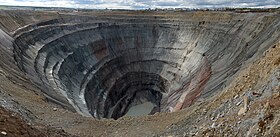Mir mine

The Mir mine in Yakutia
|
|
| Location | |
|---|---|
| Location | Mirny |
| Region | Siberia |
| Country | Russia |
| Coordinates | 62°31′45.92″N 113°59′36.74″E / 62.5294222°N 113.9935389°ECoordinates: 62°31′45.92″N 113°59′36.74″E / 62.5294222°N 113.9935389°E |
| Production | |
| Products | Diamonds |
| Production | 10,000,000 carats (2,000 kg) per year |
| Financial year | 1960s |
| History | |
| Opened | 1957 |
| Closed | 2004 |
| Owner | |
| Company | Alrosa |
| Website | http://www.alrosa.ru/about/structure/171/mirninsky_gok/ |
| Year of acquisition | 1992 |
The Mir mine (Russian: Кимберлитовая алмазная трубка «Мир» Kimberlitovaya Almaznaya Trubka "Mir"; English: kimberlite diamond pipe "Peace"), also called the Mirny mine, is a former open pit diamond mine, now inactive, located in Mirny, Eastern Siberia, Russia. The mine is 525 meters (1,722 ft) deep (4th in the world) and has a diameter of 1,200 m (3,900 ft), and is one of the largest excavated holes in the world.
The diamond-bearing deposits were discovered on June 13, 1955 by Soviet geologists Yuri Khabardin, Ekaterina Elagina and Viktor Avdeenko during the large Amakinsky Expedition in Yakut ASSR. They found traces of the volcanic rock kimberlite, which is usually associated with diamonds. This finding was the second success in the search for kimberlite in Russia, after numerous failed expeditions of the 1940s and 1950s. (The first was Zarnitsa mine, 1954.) For this discovery, in 1957 Khabardin was given the Lenin Prize, one of the highest awards in the Soviet Union.
The development of the mine started in 1957, in extremely harsh climate conditions. Seven months of winter per year froze the ground, making it hard to mine. During the brief summer months, the ground turned to slush. Buildings had to be raised on piles, so that they would not sink from the warmth of the building melting the permafrost. The main processing plant had to be built on better ground, found 20 km away from the mine. The winter temperatures were so low that car tires and steel would shatter and oil would freeze. During the winter, workers used jet engines to thaw and dig out the permafrost or blasted it with dynamite to get access to the underlying kimberlite. The entire mine had to be covered at night to prevent the machinery from freezing.
In the 1960s the mine was producing 10,000,000 carats (2,000 kg) of diamond per year, of which a relatively high fraction (20%) were of gem quality. The upper layers of the mine (down to 340 meters) had very high diamond content of 4 carats (0.80 g) per tonne of ore, with the relatively high ratio of gems to industrial stones. The yield decreased to about 2 carats (0.40 g) per tonne and the production rate slowed to 2,000,000 carats (400 kg) per year near the pit bottom. The largest diamond of the mine was found on 23 December 1980; it weighed 342.5 carats (68 g) and was named "26th Congress of the Communist Party of the Soviet Union" (Russian: XXVI съезд КПСС). The mine operation was interrupted in the 1990s at a depth of 340 m after the pit bottom became flooded, but resumed later.
...
Wikipedia

